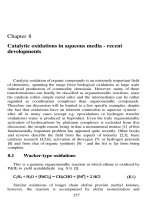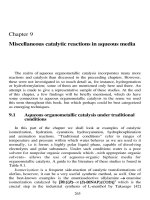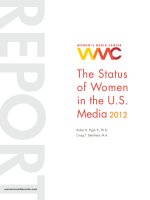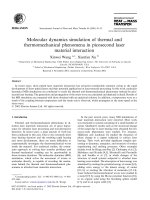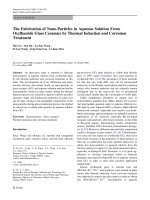Salt-induced thermal gelation of xyloglucan in aqueous media
Bạn đang xem bản rút gọn của tài liệu. Xem và tải ngay bản đầy đủ của tài liệu tại đây (7.87 MB, 10 trang )
Carbohydrate Polymers 223 (2019) 115083
Contents lists available at ScienceDirect
Carbohydrate Polymers
journal homepage: www.elsevier.com/locate/carbpol
Salt-induced thermal gelation of xyloglucan in aqueous media
a
a
a
Caroline Novak Sakakibara , Maria Rita Sierakowski , Romelly Rojas Ramírez ,
⁎
Christophe Chassenieuxb, Izabel Riegel-Vidottic, Rilton Alves de Freitasa,
a
b
c
T
BioPol, Chemistry Department, Federal University of Paraná, 81531-980, Curitiba, PR, Brazil
IMMM, UMR CNRS 6283, Polymers, Colloids, Interfaces Department, Le Mans Université, 72085, Le Mans Cedex 9, France
Macromolecules and Interface Group, Chemistry Department, Federal University of Paraná, 81531-980, Curitiba, PR, Brazil
ARTICLE INFO
ABSTRACT
Keywords:
Xyloglucan
Hydrogel
Gel
Conformation
Temperature
Kosmotropic salt
The influence of Na2SO4 as a kosmotropic salt on the thermogelation of xyloglucan (XG) solutions was measured
by rheology. The gelation occurred at lower temperatures and shorter times when the salt concentration was
increased above 0.5 mol.L−1. For Na2SO4 concentrations equal to 1 mol.L−1, a not thermoreversible elastic
hydrogel was obtained. Salts containing various types of anions were used, and it was observed that SO42−,
HPO42− and H2PO4− promoted the formation of a gelled network. The gel structure was observed using confocal
laser scanning microscopy and scanning electron microscopy. In XG containing SO42 at 1 mol.L−1aggregates and
gels were formed by interconnected sub-micrometer XG particles. Increasing the concentration of SO42− led to
conformation changes in the XG, from a twisted/helical to an extended/flat conformation, as observed using
circular dichroism. The naturally occurring hydrophobic sequences promoted an economically feasible XG
gelling that may produce thermo and kosmo-sensitive hydrogels.
1. Introduction
Xyloglucan (XG) is a neutral biopolymer extracted from legume
seeds and formed by 1→4 linked β-D-glucopyranose (Glc) units with
some glucose units substituted at O-6 by α-D-xylopyranose (Xyl), in
which some units can be substituted at O-2 by β-D-galactopyranose
(Gal) (Carpita & McCann, 2000). In water, XG forms a viscous fluid. It is
commonly employed in the food industry as an emulsifier, thickener
and emulsion stabilizer. Due to its biodegradability, biocompatibility,
bioadhesion and low-toxicity, XG is also used in the pharmaceutical
industry and in biomedical applications (Ghelardi et al., 2004; Sano
et al., 1996; Suisha et al., 1998).
These features also allow XG to be used as an in-situ gelling
polymer. An efficient way to produce hydrogels is by using partially
degalactosylated XG, in which the galactose is enzymatically removed
from the lateral chain (Brun-Graeppi et al., 2010; Nisbet et al., 2006;
Shirakawa, Yamatoya, & Nishinari, 1998; Sakakibara, Sierakowski,
Chassenieux, Nicolai, & de Freitas, 2017). Other researchers have reported the formation of thermosensitive gels from XG using eriochrome
black T (Hirun, Tantishaiyakul, & Pichayakorn, 2010), alcohols
⁎
(Yuguchi, Kumagai, Wu, Hirotsu, & Hosokawa, 2004), epigallocatechin
gallate (Nitta, Fang, Takemasa, & Nishinari, 2004), gallic acid (Hirun,
Bao, Li, Deenc, & Tantishaiyakul, 2012; Hirun, Tantishaiyakul, Sangfai,
Rugmai, & Soontaranon, 2016) and Congo red (Yuguchi, Hirotsu, &
Hosokawa, 2005).
Yuguchi, Fujiwara, Miwa, Shirakawa, and Yajima (2005) observed
color formation and gelation of XG in mixture with iodine (I5−) solutions. The authors assumed that two side-by-side XG chains were involved in the association with I5−. As previously observed by Freitas
et al. (2015), XG naturally presents some hydrophobic domains associated with Gal free XG zones. Our hypothesis is that such hydrophobic
intermolecular interactions are very sensitive to the ionic strength and
can be promoted by adding salt. They can also be combined with a
salting out effect, which is a competition between the polymer and the
salt for water.
Several manuscripts are published about the effect of salts in the
polysaccharide gelation. For example, konjac glucomannan (KGM), a
naturally gelling and acetylated polymer, forms gel induced by salts
(Yin, Zhang, Huang, & Nishinari, 2008). According to them, higher the
temperature or salt concentrations, stronger is the salting out effect,
Corresponding author.
E-mail address: (R.A. de Freitas).
/>Received 23 April 2019; Received in revised form 25 June 2019; Accepted 12 July 2019
Available online 19 July 2019
0144-8617/ © 2019 Elsevier Ltd. All rights reserved.
Carbohydrate Polymers 223 (2019) 115083
C.N. Sakakibara, et al.
Fig. 1. Time dependence of G’ and G” for solutions of 1 wt% XG with (A) 0.5 mol.L−1, (B) 0.65 mol.L−1 (C) 0.75 mol.L−1 and (D) 1.0 mol.L−1 Na2SO4. The samples
were kept for 16 h at 50 °C. (E) tg−1 (s−1) was plotted as a function of Na2SO4 concentration. The lines are guides for the eye.
promoting polymer aggregation and gelation. Based on circular dichroism (CD) there is no evidence of conformational changes and the
gelation was associated to Na2SO4 effect on intermolecular association
of KGM rather than to a chain conformation change.
The same authors observed that salts as NaCl, NaNO3 and NaSCN
have no effect on KGM gelation even at higher salt concentration
(4 mol.L−1) and high temperatures. Other salts as Na2CO3 induced the
formation of thermoreversible gels by deacetylation and salting-out
2
Carbohydrate Polymers 223 (2019) 115083
C.N. Sakakibara, et al.
Friedrich, & Thomann, 2009). For example, Paţachial et al. (2009)
observed an increase in the storage modulus (G’) when adding a kosmotropic salt, Na2SO4, to poly(vinyl alcohol), evidencing a higher
crosslinking density due to an increase in the polymer-polymer interaction.
Based on that, was proposed here the formation of gels combining
the anions from Hofmeister series and XG, a non-ionic polysaccharide
and presenting, very rarely, hydrophobic sites as published by Freitas
et al. (2015). The XG, differently of HPMC and KGM, is a non-gelling
polysaccharide, and the effect of anions SO42−, HPO42−, H2PO4− Cl−
and NO3−, maintaining the same cation will be studied. Also, the
ability of SO42− to induce both gelation and conformational transition
on XG will be investigated.
Our goal is to demonstrate the formation of thermo-responsible
hydrogels defined as a hydrogel that responds to temperature (IUPAC,
2006), induced by hydrophobic interactions sites naturally occurring in
the XG from Hymenaea courbaril seeds. In order to do so, the classic
Hofmeister series was compared through of the selection of kosmotropic to chaotropic salts possessing various anions. The gelation process was investigated using dynamic oscillatory rheology, microscopy
and CD spectroscopy.
2. Material and methods
2.1. Purification of xyloglucan
Hymenaea courbaril seeds were obtained from the “Native Forests”
Project Itatinga, São Paulo state, Brazil. The xyloglucan (XG) was extracted as previously described by Freitas et al. (2015). The polysaccharide was purified by dispersion at C = 1 wt% in ultrapure (Millipore) water by stirring for 48 h, and the dispersion was subsequently
centrifuged at 104g for 30 min at 40 °C. The polysaccharide in the supernatant was precipitated by adding 3 volumes of ethanol, washed
with pure ethanol and with acetone. The purified XG was dried overnight at 40 °C using a vacuum oven (Vacuoterm 6030A).
Fig. 2. Frequency dependence of the shear moduli G’ and G” for 1 wt% XG after
heating during 16 h at 50 °C with different Na2SO4 concentrations (no salt up to
1.00 mol.L−1).
2.2. Size exclusion chromatography (SEC)
effect (Yin et al., 2008).
Sol-gel
transition
of
thermoreversible
hydroxypropylmethylcellulose (HPMC) was evaluated by Almeida, Rakesh,
and Zhao (2014). The authors observed that HPMC sol-gel temperature
decreased in presence of NaCl and CaCl2. The gelation temperature
depended directly of the salt (NaCl, KCl and CaCl2) concentration, independent of the cation valence or anion concentration (Almeida,
Rakesh, & Zhao, 2014).
According to Almeida et al. (2014b) the bound water contents in
HPMC increased directly with salt concentration, and the behavior of
the water with salt is different at gelation temperature and at low
temperatures. However, further experiments are necessary, according
to the authors, to provide insight on the structural changes of the HPMC
solution with salts (Almeida et al., 2014b). In opposition, Liu, Joshi and
Lam (2008) assumed NaCl, KCl and CaCl2 disrupted the water cage
around HPMC groups inducing hydrophobic association, and weakened
intermolecular hydrogen bonding between hydroxyl and water.
The studies of salt effect on gelling polysaccharides is well described, however only few studies have been reported concerning the
thermal gelation of neutral and non-gelling polymers induced by salts
(Curley, Hayesa, Rowana, & Kennedy, 2014; Paţachial, Florea,
The mass-average molar mass (Mw) of native XG was determined
using size exclusion chromatography with a Viscotek GPC system
(Malvern, USA), composed of a VE1122 pump, a VE3580 differential
refractometer and a 270 dual light scattering detector with a low angle
photo-detector at 7° and a right angle photo-detector at 90°. The samples were injected into the system, and elution proceeded through a SB806 M HQ column (Shodex, Japan). Analyses were performed using
sodium nitrate (NaNO3) 0.1 mol.L−1 with 200 ppm of sodium azide
(NaN3) at pH 6 as the mobile phase with a flow rate of 0.4 ml.min−1.
The measured value was Mw = 2.6 × 106 g.mol−1, in agreement with
what was previously reported by Sakakibara et al. (2017).
2.3. Preparation of the xyloglucan-salt dispersion
The sample of XG was dispersed at C = 1 wt% in ultrapure water
with 200 ppm of sodium azide (NaN3) by overnight stirring. Sodium
sulfate was then added to the dispersion at concentrations of 0.1, 0.25,
0.5, 0.65, 0.75 and 1.0 mol.L−1, and the mixtures were stirred overnight under refrigeration prior to the investigation.
3
Carbohydrate Polymers 223 (2019) 115083
C.N. Sakakibara, et al.
Fig. 3. G’ (1) and G” (2) as a function of pulsation for XG at 1 wt% with 0.1 mol.L−1 (A); 0.5 mol.L−1 (B) and 1 mol.L−1 (C) Na2SO4 at various temperatures between
50 °C and 10 °C. The samples were kept at each temperature during 1.5 h after measurement.
2.4. Rheological measurements
the linear response regime (σ = 1 Pa), and the oscillatory shear measurements were carried out at temperatures from 10 to 50 °C. The
sample dispersion was poured onto the instrument plate at 10 °C and
heated to 50 °C, at which it remained for 16 h. To avoid evaporation,
the sample was covered with a layer of mineral oil. The gelation time
(tg), was determined at the intersection between G’ and G”.
Dynamic mechanical measurements of the XG-salt dispersion samples were performed using a Thermo Scientific HAAKE Rheostress 1
system (Karlsruhe, Germany) equipped with a cone geometry (35 mm
diameter, 2°). The shear modulus G’ and G” were measured at an angular frequency (ω) of 1 rad.s−1. The imposed stress was chosen within
4
Carbohydrate Polymers 223 (2019) 115083
C.N. Sakakibara, et al.
2.7. Circular dichroism
The CD spectra were obtained with a Jasco J-815 spectropolarimeter
(Jasco Instruments, Japan). The spectral scanning was from 195 to
250 nm, with a scanning speed of 20 nm.min−1 and two accumulations.
All the samples were maintained under nitrogen flow during the experiments. The samples were used at 0.1 wt% with or without Na2SO4, the
temperature ranging from 10 to 50 °C, with a heating rate of 1 °C.min−1.
3. Results and discussion
3.1. Influence of sodium sulfate on the XG gelation
Increasing the Na2SO4 concentration (Fig. 1A–D) caused a reduction
in the tg value (Fig. 1E) and an increase of G' at steady state after gelation. This indicates that the higher the concentration of the kosmotropic salt, the stronger the hydrophobic interactions between the
chains, leading to the formation of a denser polymer network from the
point of view of their cross-links. However, a limit value for Na2SO4 is
needed in order to achieve such a gelation, as discussed below.
After heating the sample at 50 °C during 16 h within the rheometer,
frequency sweeps were performed in order to measure G’ and G” at
steady state with various concentrations of Na2SO4 (Fig. 2). Gel formation was assessed, since G’ was much higher than G” and displayed
no frequency dependence if the Na2SO4 concentration was higher than
0.5 mol.L−1. At lower salt concentrations, there was no influence of salt
as compared to the solution of XG in plain water.
Subsequently, the samples remained at 50 °C, G' and G” values at
1 rad s−1 were measured at different temperatures during cooling from
50 °C to 10 °C. The concentrations of 0.1 mol.L−1 (Fig. 3A) and
0.25 mol.L−1 (Fig. 2) of Na2SO4 showed no significant effects on XG
during heating at 50 °C. These salt concentrations were clearly not
enough to improve the interaction between XG chains. For the samples
with low salt concentrations, the values of G’ and G” decreased with
temperature, suggesting that hydrogen bonds were broken. Similar results were found by Freitas et al. (2015) studying XG under heating and
the authors described that the transient network in XG could be associated with hydrogen bond interactions.
The sample of XG with Na2SO4 at 0.5 mol.L−1 (Fig. 3B) exhibited
thermoreversible gel characteristics at 10 °C. Thermoreversible gel was
used here, according to IUPAC, as a swollen network with thermally
reversible junction points (IUPAC, 2006). The same was observed for
XG with Na2SO4 at 0.65 mol.L−1−1 and 0.75 mol.L−1 (data not shown).
For Na2SO4 at 1 mol.L−1 no thermo-reversion was observed (Fig. 3C).
The general rheological behavior of XG with kosmotropic salt is associated with hydrophobic interactions induced by heating (Sakakibara
et al., 2017), together with weakening the hydrogen bonds of the XG.
The gelation of XG with other salts was achieved for purposes of
comparison (Fig. 4), the kosmotropic anions SO42− and HPO42− exhibiting a stronger influence on G’. It should be noted that H2PO4− (pKa
6.8) is much more chaotropic than Cl−, and theoretically cannot induce
gel formation. However, since the pH of the XG solution was 6.8, approximately 50% of H2PO4− was in equilibrium with HPO42−, presenting an intermediate kosmotropic behavior. The chaotropic anions
Cl− and NO3− had no influence on the shear modulus of XG in comparison with XG in purified water.
Fig. 4. Influence of Na2SO4, Na2HPO4, NaH2PO4, NaCl and NaNO3 at 1 mol.L−1
on the shear moduli for XG at 1 wt% after heating at 50 °C during 16 h.
2.5. Confocal laser scanning microscopy analysis (CLSM)
The images were obtained with a Nikon A1RSiMP confocal microscope (Tokyo, Japan), using lenses immersed in oil (20x, 60x with
numerical apertures of 0.75 and 1.4 respectively and 60x with zoom of
4x). The Nis Elements 4.20 imaging program (Nikon, Tokyo, Japan)
was used for visualizing the images. XG was labeled with rhodamine B
isothiocyanate (RITC). The XG-rhodamine was prepared using the
method of De-Belder and Granath (1973). Briefly, 50 mg of XG was
dispersed in 10 ml of DMSO, where 2 drops of pyridine were added. To
this dispersion, 2 mg of RITC and 20 mg of the catalyst dibutyltin dilaurate were added, and the mixture was heated at 95 °C during 2 h.
The sample was precipitated and washed several times using ethanol
and acetone, after which it was dried at 35 °C in a vacuum oven. This
XG-RITC was used at 10% of the total XG concentration for CLSM experiments.
2.6. Scanning electron microscopy (SEM)
The samples were maintained at 50 °C during 16 h, after which the
gels were frozen using liquid N2 and immediately lyophilized. The
samples were placed in a double-faced copper tape and metalized with
gold. The SEM analyses were performed with a TESCAN VEGA3 LMU
with magnification of 5kx, 20kx and 50 kx.
3.2. Analysis of the structure of the gels using microscopy
XG was labeled with isothiocyanate of rhodamine (RITC) forming
5
Carbohydrate Polymers 223 (2019) 115083
C.N. Sakakibara, et al.
Fig. 5. CLSM images of 1 wt% XG-RITC heated during 16 h in presence of Na2SO4 at no salt (0 mol.L−1), 0.5 mol.L−1, 0.75 mol.L−1 and 1.0 mol.L−1, at different
temperatures and magnification of 240x (50 x 50 μm). Excitation at 570 nm and emission at 595 nm.
the XG-RITC, and CLSM analysis was performed in order to observe the
structure of the gel at various temperatures and Na2SO4 concentrations
using images of 50 x 50 μm (Fig. 5) and 200 x 200 μm (Fig. S1). The red
emission at 595 nm was associated to the presence of XG-RITC. The
results were compared with those of a solution of XG-RITC in pure
water (Fig. 5) of XG 1 wt% and no Na2SO4 at 20 °C.
The labeling of XG with RITC has no effect on the rheological
properties compared to XG and, consequently, the CLSM images were
considered representative of the XG gelling behavior.
The CLSM images at Fig. 5 demonstrated the formation of a network
at 20, 40 and 50 °C after heating at 16 h in presence of Na2SO4. At
higher concentrations of Na2SO4, a clear formation of large polymeric
clusters of aggregates associate and percolate all the system. Only few
aggregates of XG-RITC at concentration of 1 wt% were observed in pure
water (no Na2SO4). As temperature induced the formation the gelled
network we expected it is associated to hydrophobic interactions.
Gelation kinetic studies using CLSM were obtained heating the XGRITC samples at 50 °C during 0, 1, 4, 10 and 24 h and immediately
analyzed using CLSM were also performed using 1 wt% XG with 0.5 and
1 mol.L−1 Na2SO4 (Fig. 6). Prior to analysis, the samples were prepared
at 5 °C and kept at 0 °C until the experiments were carried out. The
simple addition of an amount of salt of 1 mol.L−1 was significant
6
Carbohydrate Polymers 223 (2019) 115083
C.N. Sakakibara, et al.
Fig. 6. CSLM images of XG-RITC samples at 1 wt% and with 0.5 mol.L−1 and 1 mol.L−1 Na2SO4 concentration. The images were obtained after heating at 50 °C the
samples from 0 to 24 h. The magnification was of 60x (200 x 200 μm).
enough to cause a greater interaction between the XG chains and the
formation of large fibers, which were not observed in the native XG or
at lower salt concentration at the same time/temperature as previously
presented at Figs. 5, 6 and S1.
Experiments were also performed using freeze-dried gels, analyzed
using scanning electron microscopy (Fig. 7) for the XG without salt
(Fig. 7A) and with 0.5 (Fig. 7B), 0.75 (Fig. 7C) and 1.0 mol.L−1
(Fig. 7D) of Na2SO4. The presence of the salt induced the formation of
fibrillar structures, which were also observed using CLSM (Figs. 5, 6
and S1), and sub-micrometer particles of XG aggregated are clearly seen
at 1.0 mol.L−1 (Fig. S2).
The energy-dispersive X-ray spectroscopy (EDS) analysis was also
performed in order to observe the distribution of SO42− ions in the gel
structure as presented in Fig. S3. The anions were homogeneously
distributed in the same regions as carbon and oxygen of the polymer,
suggesting a co-presence of polysaccharide and kosmotropic anions.
However, at that time, the authors can not confirm the helical/twistedlike structure transitions by the rheological experiments.
Gaillard, Thompson, and Morak (1969) classified tamarind XG as an
amyloid molecule, and the helical/twisted molecule was associated
with the interaction with iodine ions. Related to XG from H. courbaril
seeds the conformation transition was macroscopically observed by
Gouvêa, Ribeiro, de Souza, Marvila-Oliveira, and Sierakowski (2009).
The authors visualize that XG in presence of starch and tetraborate ions
present a deep blue color, similar to that of amylose, however only
observed only in presence of XG and after shearing and heating. This
could indicate an amyloid structure in H. courbaril XG and possibly a
helical/twisted-like structure.
Jó, Petri, Beltramini, Lucyszyn, and Sierakowski (2010) studied the
influence of temperature on XG from the conformation of Tamarind
seeds using CD spectroscopy with phosphate buffer as solvent. They
observed the presence of a helical-like structure at lower temperatures,
with a transition to a sheet-like or extended conformation at temperatures of 25 °C and 37 °C, respectively. These results are in agreement
with those of the present study, despite the different XG source used.
Umemura and Yuguchi (2005) using molecular dynamic simulation
observed a XG folding mechanism dependent of the main chain condition. For a flat ribbon-like conformation, the galactoxylose side chain
interacts (stick) onto the flat surface by hydrophobic interactions, increasing the hydrophobicity. When the XG chain is not restricted it
presents a twisted conformation, loosing the folding of galactose, increasing the hydrophilicity. In our opinion, the transition from a nonrestricted (twisted/helical-conformation) to a restricted (flat/expanded
conformation), with exposure of hydrophobic sites is induced by temperature and SO42− concentration. However much more attention need
be done to confirm such hypothesis.
Koziol, Cybulska, Pieczywek, and Zdunek (2015) described, using
atomic force microscopy, that a rod-like nanomolecules of XG was
identified in a helical structure, corroborating with this twisted conformation of XG.
3.3. Conformational transition of XG due to kosmotropic salts
The CD analyses of 0.1 wt%, in the XG diluted regime according to
Freitas et al. (2015), at 0.5 and 1.0 mol.L−1 of Na2SO4 (Fig. 8B and C)
were compared with that of XG without salt (Fig. 8A).
The XG presented a transition from a twisted/helical structure at
temperatures up to 40 °C with a maximum at 198 nm and minimum at
208 and 220 nm. When the heating was greater than 40 °C, a more
extended/flat conformation/ with maximum at 202 nm and minimum
at 220 nm was observed.
The addition of kosmotropic salts also affected the conformational
transition of XG, represented by a shift to a lower wavelength, indicating that at 0.5 mol.L−1 of Na2SO4, the twisted structure changed to
an extended conformation (Fig. 8B). In the presence of 1.0 mol.L−1 of
Na2SO4 the same extended/flat conformation was observed with a
significant shift of the CD signal to positive values, indicating almost
complete loss of the helical structure with higher temperature and in
the presence of Na2SO4 (Fig. 8C).
Increasing the temperature induced a conformational transition in
the aqueous XG solution. These results are, at some point, in agreement
with previous results obtained by Freitas et al. (2015), which indicated
a quasi-permanent network in XG after the heating of this polymer,
which was associated with the “exposure” of these hydrophobic groups.
4. Conclusion
Kosmotropic salts are able to induce the formation of a gelled network in XG, induced by very sensitive hydrophobic domains naturally
occurring in this polysaccharide. We confirmed our hypothesis that the
7
Carbohydrate Polymers 223 (2019) 115083
C.N. Sakakibara, et al.
Fig. 7. Micrographs obtained using scanning electron microscopic of dried colloidal dispersions of XG at 1 wt% in water/ no salt (A) and with 0.5 mol.L−1 Na2SO4
(B); 0.75 mol.L−1 Na2SO4 (C) and 1 mol.L−1 Na2SO4 (D) using magnifications of 5kx and 20kx.
hydrophobic domains are sensitive to temperature and to salts due to a
competition for water. Another important consideration is that XG
displayed a conformational transition from a helical structure to a more
extended conformation during heating, sensitive to the presence of salt.
This induced the formation of sub-micrometric particles of XG responsible for the formation of gelling structures.
Acknowledgements
We acknowledge the Brazilian funding agencies CNPq (Conselho
Nacional de Pesquisa, process number 430451/2018-0) and CAPES
(Coordenaỗóo de Aperfeiỗoamento de Pessoal de Nível Superior – Brasil
– Finance Code 001) and CAPES/PrInt (88887.311748/2018-00).
8
Carbohydrate Polymers 223 (2019) 115083
C.N. Sakakibara, et al.
Fig. 8. CD spectra of 0.1 wt% XG in no salt (A), 0.5 mol.L−1 (B) and 1.0 mol.L−1 (C) Na2SO4 analyzed at different temperatures.
R.A.F. (CNPq 301172/2016-1), M.-R.S. (CNPq 306245/2014-0) and
I.R.V (CNPq 306038/2017-0) are CNPq researchers. We are also
grateful to center of advanced technology in fluorescence at UFPR for
confocal analysis.
keratitis. Antimicrobial Agents and Chemotherapy, 48, 3396–3401.
Gaillard, B. D. E., Thompson, N. S., & Morak, A. J. (1969). The interaction of polysaccharides with iodine: part I. Investigation of the general nature of the reaction.
Carbohydrate Research, 11, 509–519.
Gouvêa, M. R., Ribeiro, C., de Souza, C. F., Marvila-Oliveira, I., & Sierakowski, M.-R.
(2009). Rheological behavior of borate complex and polysaccharides. Materials
Science and Engineering C, 29(2), 607–612.
Hirun, N., Tantishaiyakul, V., & Pichayakorn, W. (2010). Effect of Eriochrome Black T on
the gelatinization of xyloglucan investigated using rheological measurement and
release behavior of Eriochrome Black T from xyloglucan gel matrices. International
Journal of Pharmaceutics, 388, 196–201.
Hirun, N., Bao, H., Li, L., Deenc, G. R., & Tantishaiyakul, V. (2012). Micro-DSC, rheological and NMR investigations of the gelation of gallic acid and xyloglucan. Soft
Matter, 8, 7258–7268.
Hirun, N., Tantishaiyakul, V., Sangfai, T., Rugmai, S., & Soontaranon, S. (2016). Nanostructure, phase transition and morphology of gallic acid and xyloglucan hydrogel.
Polymer Bulletin, 73, 2211–2226.
IUPAC (2006). Compendium of chemical terminology. In A. D. McNaught, & A. Wilkinson
(Eds.). The “Gold book”(2nd ed.). Oxford: Blackwell Scientific Publications. https://
doi.org/10.1351/goldbook.
Jó, T. A., Petri, D. F. S., Beltramini, L. M., Lucyszyn, N., & Sierakowski, M. R. (2010).
Xyloglucan nano-aggregates: Physico-chemical characterization in buffer solution
and potential application as a carrier for camptothecin, an anti-cancer drug.
Carbohydrate Polymers, 82, 355–362.
Koziol, A., Cybulska, J., Pieczywek, P. M., & Zdunek, A. (2015). Evaluation of structure
and assembly of xyloglucan from Tamarind seed (Tamarindus indica L.) with atomic
force microscopy. Food Biophysics, 10, 396–402.
Liu, S. Q., Joshi, S. C., & Lam, Y. C. (2008). Effects of salts in the Hofmeister series and
solvent isotopes on the gelation mechanisms for hydroxypropylmethylcellulose hydrogels. Journal of Applied Polymer Science, 109, 363–372.
Nisbet, D. R., Crompton, K. E., Hamilton, S. D., Shirakawa, S., Prankerd, R. J., Finkelstein,
D. I., et al. (2006). Morphology and gelation of thermosensitive xyloglucan hydrogels. Biophysical Chemistry, 121, 14–20.
Nitta, Y., Fang, Y., Takemasa, M., & Nishinari, K. (2004). Gelation of xyloglucan by addition of epigallocatechin gallate as studied by rheology and differential scanning
calorimetry. Biomacromolecules, 5, 1206–1213.
Paţachial, S., Florea, C., Friedrich, C., & Thomann, Y. (2009). Tailoring of poly(vinyl
alcohol) cryogels properties by salts addition. Polymer Letters, 3, 320–331.
Sakakibara, C. N., Sierakowski, M. R., Chassenieux, C., Nicolai, T., & de Freitas, R. A.
Appendix A. Supplementary data
Supplementary material related to this article can be found, in the
online version, at doi: />References
Almeida, N., Rakesh, L., & Zhao, J. (2014a). Phase behavior of concentrated hydroxypropyl methylcellulose solution in the presence of mono and divalent salt.
Carbohydrate Polymers, 99, 630–637.
Almeida, N., Rakesh, L., & Zhao, J. (2014b). Monovalent and divalent salt effect on
thermogelation of aqueous hypromellose solutions. Food Hydrocolloids, 36, 323–331.
De-Belder, A. N., & Granath, K. (1973). Preparation and properties of fluorescein-labelled
dextrans. Carbohydrate Research, 30, 375–378.
Brun-Graeppi, A. K. A. S., Richar, C., Bessodes, M., Scherman, D., Narita, T., Ducouret, G.,
et al. (2010). Study on the sol-gel transition of xyloglucan hydrogels. Carbohydrate
Polymers, 80, 555–562.
Carpita, N., & McCann, M. (2000). The cell wall. In B. B. Buchanan, W. Gruissem, & R. L.
Jones (Eds.). Biochemistry and molecular biology of plants. Maryland: American Society
of Plant Physiologist.
Curley, C., Hayesa, J. C., Rowana, N. J., & Kennedy, J. E. (2014). An evaluation of the
thermal and mechanical properties of a salt-modified polyvinyl alcohol hydrogel for a
knee meniscus application. Journal of the Mechanical Behavior of Biomedical Materials,
40, 13–22.
Freitas, R., Spier, V. C., Sierakowski, M. R., Nicolai, T., Benyahia, L., & Chassenieux, C.
(2015). Transient and quasi-permanent network in xyloglucan solutions.
Carbohydrate Polymers, 129, 216–223.
Ghelardi, E., Tavanti, A., Davini, P., Celandroni, F., Salvetti, S., Parisio, E., et al. (2004). A
mucoadhesive polymer extracted from tamarind seed improves the intraocular penetration and efficacy of rufloxacin in topical treatment of experimental bacterial
9
Carbohydrate Polymers 223 (2019) 115083
C.N. Sakakibara, et al.
(2017). Xyloglucan gelation induced by enzymatic degalactosylation; kinetics and the
effect of the molar mass. Carbohydrate Polymers, 174, 517–523.
Sano, M., Miyata, E., Tamano, S., Hagiwara, A., Ito, N., & Shirai, T. (1996). Lack of
carcinogenicity of tamarind seed polysaccharide in B6C3F1 mice. Food and Chemical
Toxicology, 34, 463–467.
Shirakawa, M., Yamatoya, K., & Nishinari, K. (1998). Tailoring of xyloglucan properties
using an enzyme. Food Hydrocolloids, 12, 25–28.
Suisha, F., Kawasaki, N., Miyazaki, S., Shirakawa, M., Yamatoya, K., Sasaki, M., et al.
(1998). Xyloglucan gels as sustained release vehicles for the intraperitoneal administration of mitomycin C. International Journal of Pharmaceutics, 172, 27–32.
Umemura, M., & Yuguchi, Y. (2005). Conformational folding of xyloglucan side chain in
aqueous solution from molecular dynamics simulation. Carbohydrate Research, 340,
2520–2532.
Yin, W., Zhang, H., Huang, L., & Nishinari, K. (2008). Effects of the lyotropic series salt on
the gelation of konjac glucomannan in aqueous solutions. Carbohydrate Polymers, 74,
68–78.
Yuguchi, Y., Kumagai, T., Wu, M., Hirotsu, T., & Hosokawa, J. (2004). Gelation of xyloglucan in water/alcohol systems. Cellulose, 11, 20–208.
Yuguchi, Y., Fujiwara, T., Miwa, H., Shirakawa, M., & Yajima, H. (2005). Color formation
and gelation of xyloglucan upon addition of iodine solutions. Macromolecular Rapid
Communications, 26, 1315–1319.
Yuguchi, Y., Hirotsu, T., & Hosokawa, J. (2005). Structural characteristics of xyloglucan –
Congo red aggregates as observed by small angle X-ray scattering. Cellulose, 12,
469–477.
10
